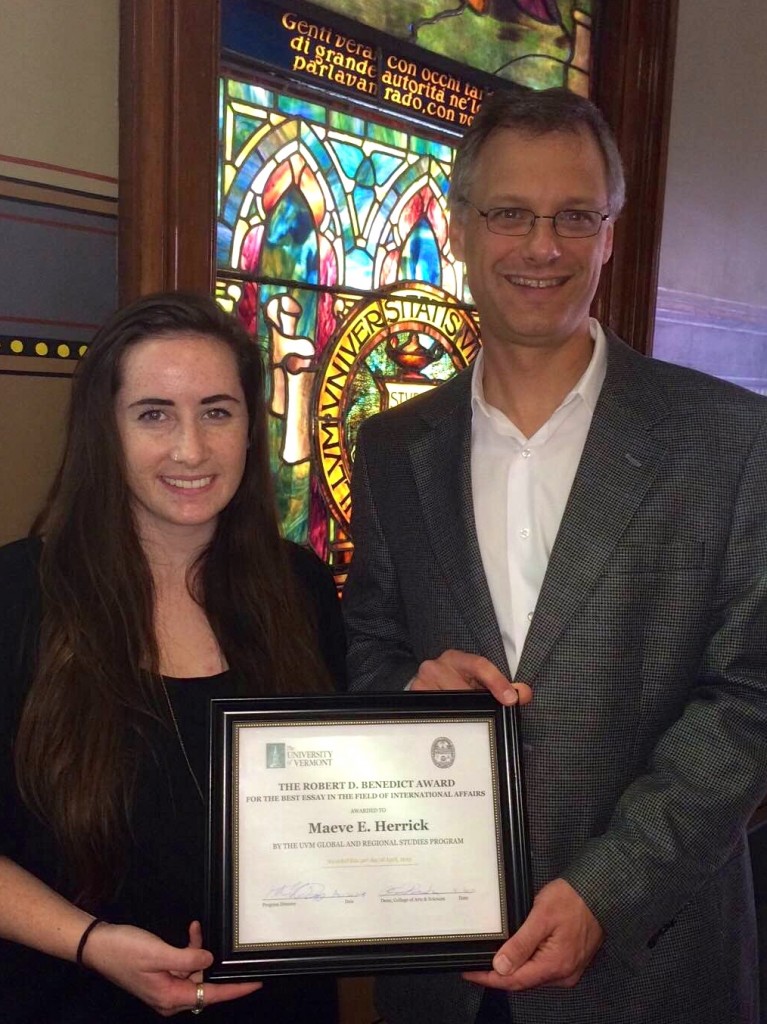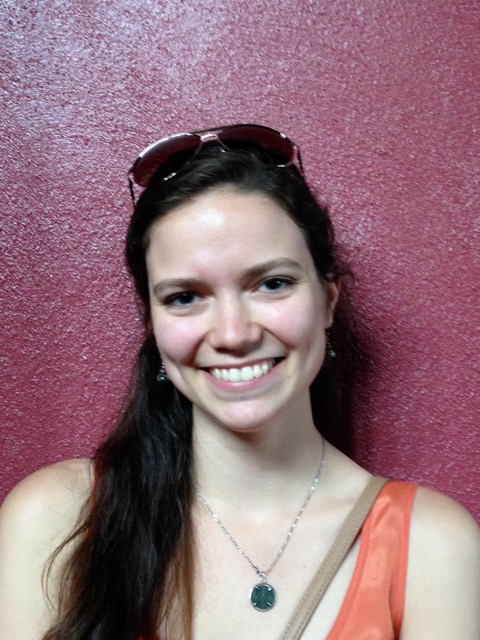
Maeve receiving the Robert B. Benedict Award from Prof. Peter vonDoepp. Global & Regional Studies Interim Director
Maeve Herrick, a senior Religion major, was presented with the Robert D. Benedict Award for the Best Essay in the Field of International Affairs. Her essay is entitled, “The Sacred City of Anuradhapura: Perpetuating Sinhala Buddhist Nationalism through a UNESCO World Heritage Site.”
Some reflections on my research by Maeve Herrick
Coming up with a topic for my senior paper, which I would be working on over two semesters, was daunting. I was in the class, Buddhism in Sri Lanka, so my topic was going to connect to the title of the course, generally. Because I am a religion and anthropology double major, I also wanted the project to connect in some way to archaeology, which is my concentration in anthropology. Professor Trainor suggested that I look into the “Sacred City of Anuradhapura,” a UNESCO World Heritage Site in Sri Lanka. As I began to research the city my topic solidified and I became interested in understanding the relationships between Buddhism, Sinhala nationalism, and UNESCO and the ways in which those relationships have been manifested in Anuradhapura. I discovered that the position of the Sacred City of Anuradhapura as a UNESCO World Heritage Site is significant because it exemplifies how UNESCO may be used as a pawn by nationalists who wish to legitimize and create enduring claims to a place. My research on the Sacred City of Anuradhapura explores different narratives concerning the history of the city, the ways that the city was reimagined by Sinhala Buddhist nationalists throughout the twentieth century, and how its inscription as a UNESCO World Heritage site is problematic.
UNESCO TV video on the Great Bodhi Tree in Anuradhapura
http://whc.unesco.org/en/list/200/video
A substantial part of my research was involved in examining Sinhala Buddhist Nationalist Brahmacari Harischandra’s claims concerning Anuradhapura, and understanding both how his imagining of the city is inaccurate, and why he constructs the city in the way he does. Harischandra argues that the British presence and archaeological research in Anuradhapura is desecrating the monuments there, that the city is a solely Sinhala Buddhist space, and that the ancient city was physically separated into secular and sacred spaces (Harischandra 1908). It is because of his opposition to British colonialism, his efforts towards the “regeneration of Buddhism and Sinhala culture that had both declined under the harmful influences of colonialism (Seneviratne 1999:28-9),” and his belief that the Sinhala nation has sole rights to the city and to Sri Lanka that Harischandra constructs the history and space of the city in a way that marginalizes other groups in the city (Harischandra 1908, Berkwitz 2004, 35).
Despite the inaccuracies of Harischandra’s understanding of Anuradhapura, in 1948 the city of Anuradhapura was constructed in such a way that Sinhala Buddhist Nationalism became physically manifested in the space (Nissan 1989, 65). Non-Buddhist religious buildings, such as churches, a mosque, and a Hindu temple were removed from the old city of Anuradhapura and many families were relocated from the old city and moved to the nearby New City (Nissan 1989, 65-74). The destruction of Hindu, Muslim, and Christian religious buildings is symbolic; the people connected to these buildings are not understood to be a part of the nation that is laying claim to the space they occupied, and to the entire island. This construction of Anuradhapura places it as a Sinhala Buddhist place, creating a physical space for the nation of Sinhala Buddhists to claim exclusive heritage.
I was also concerned with the way that UNESCO has been used to legitimize and perpetuate Sinhala Buddhist Nationalist claims to the city. In 1982 the Sacred City of Anuradhapura became a UNESCO World Heritage Site (UNESCO World Heritage Centre. 2015). The process of inscription for World Heritage Sites is problematic and has been criticized because sites are nominated by those who possess power (Askew 2010, 22). The Sinhala Buddhist government advocated for Anuradhapura to become a World Heritage Site (Silva 1988, 18). Representations, narratives, and the physical space of the city perpetuate and embody the city as the foundation of Sinhala Buddhist nationhood while marginalizing Tamil and other groups within Anuradhapura (Askew 2010, 22). Inscription as a UNESCO World Heritage Site legitimizes these narratives, in addition to providing monetary support for continued preservation of the city (Askew 2010, 22, World Heritage Centre 2008, 10).
The severity of the Sinhala Buddhist Nationalist claim to Anuradhapura is evident in a 1985 Tamil attack on the city, where many people were killed, including a number of bhikkhus and bhikkhunis [Buddhist monks and nuns] who were at the Sri Maha Bodhiya, the most important site for Sri Lankan Buddhists (Wickremeratne 2006, 158-159, The Globe and Mail 1985, The Guardian 1985, Nissan 1989, 65). Elizabeth Nissan contextualizes the attack, “In stopping to attack this tree, it could be argued, the gunmen (presumed to have been Tamil ‘Tigers’) attacked a whole construction of the island as continuously and inviolably Sinhala Buddhist” (Nissan 1989, 65). I show that this act of violence was in part a product of decades of nation building, heritage construction, and hegemonic claims to Anuradhapura by Sinhala Buddhist Nationalists (Nissan 1989, 65-67). This construction of knowledge, heritage, and nationhood was aided and legitimized by the inscription of Anuradhapura as a UNESCO World Heritage Site, which was advocated by those who would benefit most from exclusive claims to Sri Lankan history (Silva 1988, 18).
My research on Anuradhapura exemplifies the ways in which archaeology can be misused by those in power in order to perpetuate nationalist ideologies, to make hegemonic claims to archaeological sites, and to disenfranchise certain groups from their heritage. In the fall I will be pursuing my master’s degree in anthropology with a concentration in archaeology at the University of Denver. I plan to focus on the ways in which archaeologists can better engage with the public in order to change and improve the ways in which knowledge about the past is constructed.
Bibliography:
- “Tamil attack kills eighty / Massacre of civilians in Sri Lankan town of Anuradhapura.” The Guardian (London). (May 15).
- “Toll climbs to 145 in Tamil massacre.” The Globe and Mail (Canada). (May 15).
Askew, Marc. 2010. “The Magic List of Global Status: UNESCO, World Heritage and the Agnedas of States.” In Heritage and Globalisation, edited by Sophia Labadi and Colin Long, 19-44. New York, NY: Routledge.
Berkwitz, Stephen C. 2004. “History and Textuality.” In Buddhist History in the Vernacular: The Power of the Past in Late Medieval Sri Lanka, 20-37. Boston, MA: Brill. Blackboard.
Greenwald, Alice. 1978. “The Relic on the Spear: Historiography and the Saga of Dutthagamani.” In Religion and Legitimation of Power in Sri Lanka, edited by Bardwell L. Smith, 13-35. Chambersburg, PA: Conococheague Associates, Inc.
Harischandra, Walsinha. 1908. The Sacred City of Anuradhapura. University of California. Accessed October 17, 2014. Google Books.
The Mahavamsa or The Great Chronicle of Ceylon. 1912. Translated by Wilhelm Geiger, London: Oxford University Press. University of California CDL. Ebscohost.
Nissan, Elizabeth. 1989. “History in the Making: Anuradhapura and the Sinhala Buddhist Nation.” Social Analysis: The International Journal of Social and Cultural Practice 25 Identity, Consciousness and The Past: The South Asian Scene, 64-77.
Silva, Roland. 1988. “The Cultural Triangle of Sri Lanka: One Of 32 International Cultural Heritage Projects Launched by UNESCO.” Icomos information 3: 26-35.
UNESCO World Heritage Centre. 2015. “Sacred City of Anuradhapura: Description.” UNESCO World Heritage Center. Accessed May 16, 2015. http://whc.unesco.org/en/list/200
Wickremeratne, Swarna. 2006. “Bodhi Puja: All for the Sake of a Tree.” In Buddha in Sri Lanka, 157-166. Albany, NY: State University of New York Press.

